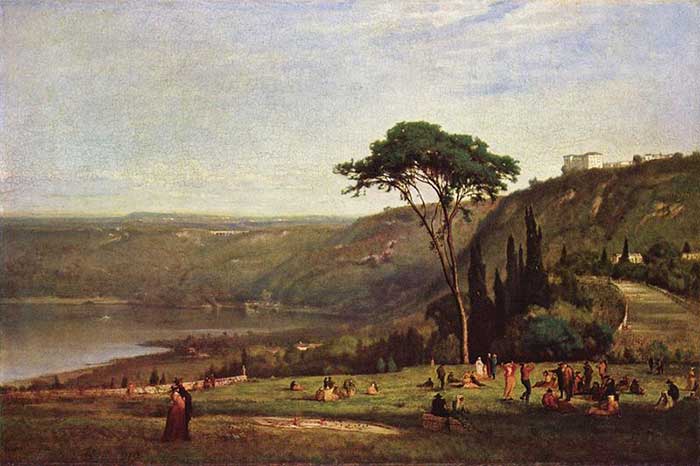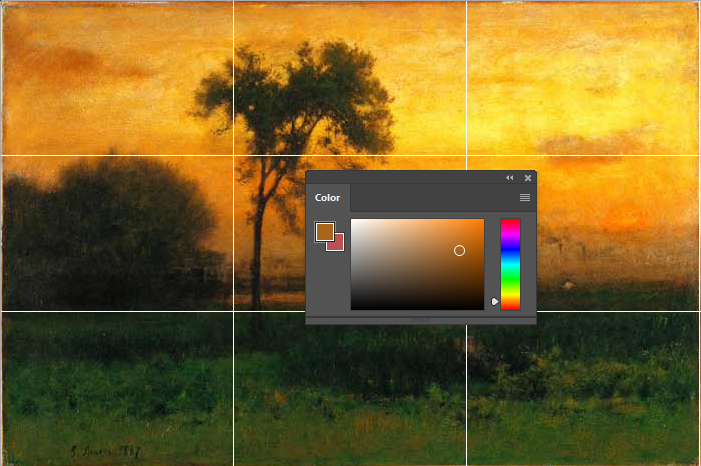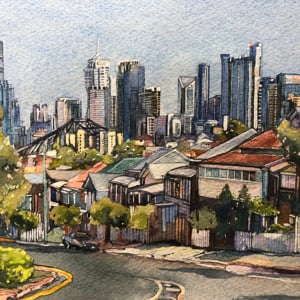
George Inness (1825 – 1894) was one of the top American landscape painters known for his ability to depict atmosphere, mood and emotion through his paintings.
His paintings are very unique and few artists seem to have been able to produce some atmospheric displays. He was a figurehead of what is known as the tonalist movement.
The tonalist movement was defined by atmospheric landscapes which were painted with dark and often dull tones.
What I love about many of George Inness’ paintings is the contrast between areas of atmospheric and soft color and more delicate areas of detail and saturated color.
To give you an idea of George Inness’ mindset and thoughts on painting, here are some of his quotes:
“The greatness of art is not in the display of knowledge, or in material accuracy, but in the distinctness with which it conveys the impressions of a personal vital force, that acts spontaneously, without fear or hesitation.”
“We are all the subjects of impressions, and some of us seek to convey the impressions to others. In the art of communicating impressions lies the power of generalizing without losing the logical connection of parts to the whole which satisfies the mind.”
“The true end of art is not to imitate a fixed material condition, but to represent a living emotion.”
“The purpose of the painter is simply to reproduce in other minds the impression which a scene has made upon him. A work of art does not appeal to the intellect. It does not appeal to the moral sense. Its aim is not to instruct, not to edify, but to awaken an emotion.”
I think these quotes indicate why Inness was able to create paintings with such an ethereal and atmospheric quality. He did not seem focused so much on the perfect rendering of scenes but instead merely translating how he felt. With that being said, his paintings are remarkably complex in a technical sense.
One thing to learn from Inness is that technical knowledge alone will not allow you to create beautiful art. You also need to understand how people interpret things. If you do not understand how the human mind works and how we interpret things, then you will not be able to connect with people through your paintings.
Let’s take a look at some of his beautiful paintings.
















(Before diving into this post, make sure to pick up a copy of my free Landscape Painting Starter Kit.)
How Did Inness Create Such Luminous Paintings?
One of the fascinating things about George Inness’ paintings is how he was able to portray light with such luminosity.
Portraying light is difficult in paintings as we are not able to actually paint light. All we can do is paint the illusion of light.
Take a look at this painting:

Let’s analyze this painting to try and determine how he created such a luminous sunset.
First, here is the painting in grayscale so we can clearly see the balance between light and dark (often referred to as notan). Observe the sharp contrast between the very dark values and the mid-high values.

Now, let’s take a look at the colors used.
For the darks, he used very dark greens (almost black).

Above the darks, Inness started to work into dark oranges and reds.

Finally, for the lightest parts of the painting Inness used very high saturation yellows and oranges.

Overall, this is a remarkably simple color palette, but it produces some stunning results.
I hope you enjoyed these paintings. I recommend you read more about his story as you can learn much from him.
Want to Learn More?
You might be interested in my Painting Academy course. I’ll walk you through the time-tested fundamentals of painting. It’s perfect for absolute beginner to intermediate painters.
Thanks for Reading!
I appreciate you taking the time to read this post and I hope you found it helpful. Feel free to share it with friends.
Happy painting!
Dan Scott

Draw Paint Academy







Thank you so much for all the trouble you took to show the lights and darks in his paintings. Easy to watch nut not always so easy to get right!
Wow! I have never heard of Geaorge Inness. What an extraordinary painter. I love all the paintings you displayed. I must learn more about him. Loved the show and thank you.
No problem Margie. He is not as well known as some of the more popular names. But his paintings are certainly unique.
Dan
Thanks once again for your efforts Dan, I love his work, and I think my own work is improving after reading your blogs! Have a happy Xmas!
Really glad to hear Norm!
You too.
Dan
Thanks for the artistic moment. The concept of ligh versus dark is something g I knew but adding the concept of depth of colour will bring new ideas to life for me. Thanks again
No problem Elaine 🙂
Dan
“The true end of art is not to imitate a fixed material condition, but to represent a living emotion.” … I love this…
I have a painting by George Inness of an Alpine lakeside scene painted in oil on canvas I like it very
much but have no idea of its value it is about 2′ 6 by 2′ approximately and is signed Nit G Ol in the
bottom left corner. Please can you give me an indication of its value?
Hi Ken. I am jealous! But I am not sure what the value could be. Might need to take it to a valuer. Dan
Thank you for sharing your insight into the lights and darks of the paintings of
George Inness. (Always felt they were too dark until now)